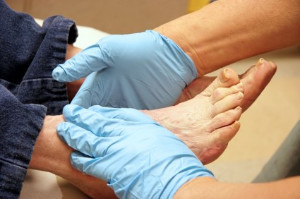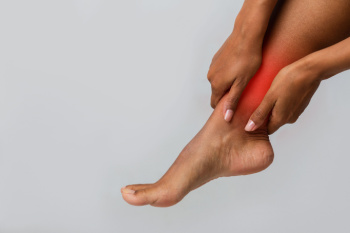Same Day or Next Day Appointments Available Laredo (956) 726-9797 Se Habla Español
Same Day or Next Day Appointments Available Laredo (956) 726-9797 Se Habla Español

A diabetic foot ulcer is an open wound or sore that develops on the foot, commonly in individuals with diabetes. It is caused by a combination of poor circulation, nerve damage, and delayed wound healing. Symptoms include redness, swelling, drainage, and, in some cases, infection or foul odor. Among the risk factors are uncontrolled blood sugar, poor foot hygiene, wearing ill-fitting shoes, and a history of foot ulcers. Proper management involves keeping the wound clean, relieving pressure, and monitoring for infection. A podiatrist plays a critical role by providing wound care, custom footwear options, and education to prevent complications. If you have diabetes, it is suggested that you are under the care of a podiatrist who can help you to manage this serious condition.
Diabetic foot care is important in preventing foot ailments such as ulcers. If you are suffering from diabetes or have any other concerns about your feet, contact Jed Wells, DPM from Jed Wells, DPM Foot Specialist. Our doctor can provide the care you need to keep you pain-free and on your feet.
Diabetic Foot Care
Diabetes affects millions of people every year. The condition can damage blood vessels in many parts of the body, especially the feet. Because of this, taking care of your feet is essential if you have diabetes, and having a podiatrist help monitor your foot health is highly recommended.
The Importance of Caring for Your Feet
Patients with diabetes should have their doctor monitor their blood levels, as blood sugar levels play such a huge role in diabetic care. Monitoring these levels on a regular basis is highly advised.
It is always best to inform your healthcare professional of any concerns you may have regarding your feet, especially for diabetic patients. Early treatment and routine foot examinations are keys to maintaining proper health, especially because severe complications can arise if proper treatment is not applied.
If you have any questions, please feel free to contact our offices located in Corpus Christi, and Laredo, TX . We offer the newest diagnostic and treatment technologies for all your foot care needs.

Ankle pain can interrupt daily life, whether it stems from an old injury, overuse, arthritis, or a sudden twist. It may appear as swelling, stiffness, or sharp discomfort when walking or standing. Without the right care, even mild symptoms can worsen over time and limit mobility. Rest, elevation, and wearing supportive footwear may help in the short term, but lasting relief depends on identifying the cause. A podiatrist can assess whether the pain is due to joint damage, ligament strain, or another issue entirely. Treatment might include custom orthotics or bracing to support healing. Because ankles play such a key role in balance and movement, ongoing pain should not be ignored. If your ankle remains sore or unstable, it is suggested that you see a podiatrist to find the right treatment and keep your steps steady and pain-free.
Ankle pain can be caused by a number of problems and may be potentially serious. If you have ankle pain, consult with Jed Wells, DPM from Jed Wells, DPM Foot Specialist. Our doctor will assess your condition and provide you with quality foot and ankle treatment.
Ankle pain is any condition that causes pain in the ankle. Due to the fact that the ankle consists of tendons, muscles, bones, and ligaments, ankle pain can come from a number of different conditions.
Causes
The most common causes of ankle pain include:
Symptoms
Symptoms of ankle injury vary based upon the condition. Pain may include general pain and discomfort, swelling, aching, redness, bruising, burning or stabbing sensations, and/or loss of sensation.
Diagnosis
Due to the wide variety of potential causes of ankle pain, podiatrists will utilize a number of different methods to properly diagnose ankle pain. This can include asking for personal and family medical histories and of any recent injuries. Further diagnosis may include sensation tests, a physical examination, and potentially x-rays or other imaging tests.
Treatment
Just as the range of causes varies widely, so do treatments. Some more common treatments are rest, ice packs, keeping pressure off the foot, orthotics and braces, medication for inflammation and pain, and surgery.
If you have any questions please feel free to contact our offices located in Corpus Christi, and Laredo, TX . We offer the newest diagnostic tools and technology to treat your foot and ankle needs.

Exercise can support healing and strength for many foot conditions when done at the right level. Gentle stretching and strengthening movements may help improve flexibility and reduce discomfort. It is important to aim for minimal or acceptable pain during activity, which means a mild ache that does not increase or linger. Excessive pain, sharp discomfort, or swelling after exercise may signal overuse or improper technique. A podiatrist can recommend specific exercises based on your condition, monitor progress, and guide you on safe intensity. If you have ongoing foot pain or are unsure of which stretches are best, it is suggested that you visit a podiatrist to create a plan that supports recovery, mobility, and long-term foot health.
Stretching the feet is a great way to prevent injuries. If you have any concerns with your feet consult with Jed Wells, DPM from Jed Wells, DPM Foot Specialist. Our doctor will assess your condition and provide you with quality foot and ankle treatment.
Stretching the Feet
Stretching the muscles in the foot is an important part in any physical activity. Feet that are tight can lead to less flexibility and make you more prone to injury. One of the most common forms of foot pain, plantar fasciitis, can be stretched out to help ease the pain. Stretching can not only ease pain from plantar fasciitis but also prevent it as well. However, it is important to see a podiatrist first if stretching is right for you. Podiatrists can also recommend other ways to stretch your feet. Once you know whether stretching is right for you, here are some excellent stretches you can do.
It is best to go easy when first stretching your foot and work your way up. If your foot starts hurting, stop exercising and ice and rest the foot. It is advised to then see a podiatrist for help.
If you have any questions please contact our offices located in Corpus Christi, and Laredo, TX . We offer the newest diagnostic and treatment technologies for all your foot and ankle needs.

Ingrown toenails occur when the edge of the nail grows into the surrounding skin, causing pain, swelling, and sometimes infection. Common causes include improper trimming like rounding the corners, tight shoes, trauma, or genetic predisposition. While most people know ingrown nails cause pain at the toe’s edge, a lesser-known issue is chronic recurrence, which can lead to thickened skin and nail deformities over time. Symptoms include redness, tenderness, swelling, and sometimes drainage or pus. The area may feel warm and throb with each step, making walking or wearing shoes uncomfortable. Over time, untreated cases can lead to serious infections or skin overgrowth. A podiatrist can diagnose the condition through a simple exam. Treatment ranges from conservative care to partial or full nail removal for persistent cases. Proper nail care education and footwear advice can also help prevent recurrence. If you are dealing with this painful condition, it is suggested that you make an appointment with a podiatrist for evaluation and treatment.
Ingrown toenails may initially present themselves as a minor discomfort, but they may progress into an infection in the skin without proper treatment. For more information about ingrown toenails, contact Jed Wells, DPM of Jed Wells, DPM Foot Specialist. Our doctor can provide the care you need to keep you pain-free and on your feet.
Ingrown Toenails
Ingrown toenails are caused when the corner or side of a toenail grows into the soft flesh surrounding it. They often result in redness, swelling, pain, and in some cases, infection. This condition typically affects the big toe and may recur if it is not treated properly.
Causes
You are more likely to develop an ingrown toenail if you are obese, have diabetes, arthritis, or have any fungal infection in your nails. Additionally, people who have foot or toe deformities are at a higher risk of developing an ingrown toenail.
Symptoms
Some symptoms of ingrown toenails are redness, swelling, and pain. In rare cases, there may be a yellowish drainage coming from the nail.
Treatment
Ignoring an ingrown toenail can have serious complications. Infections of the nail border can progress to a deeper soft-tissue infection, which can then turn into a bone infection. You should always speak with your podiatrist if you suspect you have an ingrown toenail, especially if you have diabetes or poor circulation.
If you have any questions, please feel free to contact our offices located in Corpus Christi, and Laredo, TX . We offer the newest diagnostic and treatment technologies for all your foot care needs.

Gout is a form of inflammatory arthritis caused by a buildup of uric acid crystals in the joints, most commonly affecting the big toe. This condition leads to sudden, intense pain, redness, swelling, and difficulty walking. Foods high in purines, such as red meat, shellfish, and sugary drinks, can trigger gout attacks. To help prevent flares ups, incorporate more low-fat dairy, whole grains, vegetables, and water into your diet. A podiatrist can diagnose gout through examination and testing, provide medications to reduce inflammation, and recommend lifestyle adjustments to manage symptoms. If you suffer from joint pain in your foot, particularly in the big toe, it is strongly suggested that you are under the care of a podiatrist who can help you to manage gout.
Gout is a painful condition that can be treated. If you are seeking treatment, contact Jed Wells, DPM from Jed Wells, DPM Foot Specialist. Our doctor will treat your foot and ankle needs.
What Is Gout?
Gout is a form of arthritis that is characterized by sudden, severe attacks of pain, redness, and tenderness in the joints. The condition usually affects the joint at the base of the big toe. A gout attack can occur at any random time, such as the middle of the night while you are asleep.
Symptoms
Risk Factors
Prior to visiting your podiatrist to receive treatment for gout, there are a few things you should do beforehand. If you have gout you should write down your symptoms--including when they started and how often you experience them, important medical information you may have, and any questions you may have. Writing down these three things will help your podiatrist in assessing your specific situation so that he or she may provide the best route of treatment for you.
If you have any questions, please feel free to contact our offices located in Corpus Christi, and Laredo, TX . We offer the newest diagnostic and treatment technologies for all your foot care needs.







